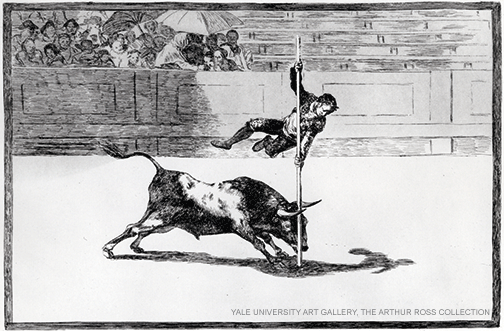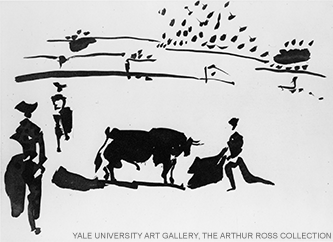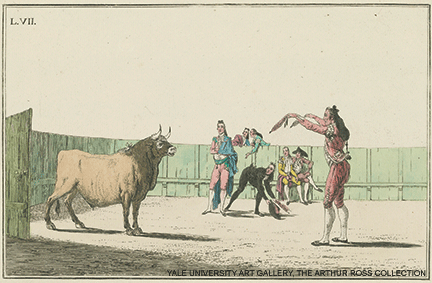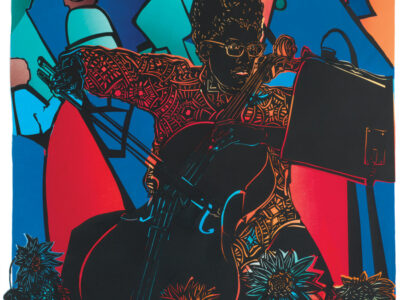
Francisco Goya y Lucientes: Ligereza y atrevimiento de Juanito Apiñani en la de Madrid (The agility and audacity of Juanito Apinani in [the ring] at Madrid) 1816.
When she approached the Arthur Ross Foundation two years ago, Lynn Marsden-Atlass had a couple of things in mind. One was that the Arthur Ross Gallery would be celebrating its 30th anniversary this year, and as its director, she wanted to celebrate that milestone with an appropriately important show. Furthermore, the foundation would be dissolving itself at the end of 2012. While she didn’t know what it planned to do with its significant art collection, she hoped that, at the very least, it would make its contents available to the gallery that shared the late philanthropist-collector’s name.
“I said, ‘I’d like to do an exhibition from your collection in honor of Arthur Ross [W’31 Hon’92] for the 30th anniversary,’” Marsden-Atlass recalls. “The timing was perfect to request a last hurrah and have that collection be available to us. So I wanted it to be a looking back and a looking forward.”
The result of that double vision is La Tauromaquia: Carnicero, Goya, and Picasso, which opened last month, runs through July 28, and features some 70 bullfighting prints by Pablo Picasso, Francisco Goya, and the 18th-century neoclassicist Antonio Carnicero. A symposium and other events connected to the show were also scheduled for last month and this fall.
The looking-back part comes from the fact that the gallery’s inaugural exhibition in 1983, curated by former director Dilys Weingrad Gr’70, also featured some of Goya’s Tauromaquia prints from Ross’s collection. The looking-forward part is that Goya’s bullfighting prints are spectacularly augmented by those of Picasso and contextualized by those of Carnicero.
The dissolution of the foundation led to some more good news for the gallery, as well as some disappointment. On the plus side, the foundation gave, as its final gift, $1 million to establish the Arthur Ross Exhibition Fund—a “transformative gift,” says Marsden-Atlass, one that will “enable us to have funding for things like symposia, lectures, loan fees for special exhibitions, and educational as well as scholarly programming.”
The disappointing news was that the foundation decided to give its entire art collection to Yale University, even though Ross himself was a Penn alumnus and had no significant connection to Yale. What Yale did have was a museum that could accommodate the collection. Since Penn does not, Marsden-Atlass knew it would never get all of it, though she had hoped that it might get a portion. But while she admits to being “very disappointed” by the foundation’s decision, she is “very pleased that we have the last working exhibition that was approved by the foundation.” Yale is now lending it as part of its Arthur Ross Collection.
[column col=”1/2″]

Pablo Picasso: Citando Al Toro con la Capa (Provoking the Bull with the Cape) from the series La Tauromaquia, 1957.
[/column]
The three artists’ prints cover parts of three centuries and represent a profound evolution of technique as well as the genius of the two masters, Goya and Picasso.
The emotionally spare, hand-tinted Carnicero etchings, made in 1790, were intended to “document the three different stages of bullfighting in the Spanish tradition,” yet are “much more inspired by Italian 18th-century art,” says Marsden-Atlass. “Where Goya takes it, it’s a whole other thing.”
Both Goya and Picasso were in their seventies when they made their prints, and both were bullfight aficionados, she notes. “I think it’s the dance of death between the matador and the bull” that attracted both artists, as well as the sense of “honor in the ring.”
In the case of Goya, “you have an incredible master of etching and aquatinting dry point, and marvelous light and shadow, and the very dramatic gestures of the figures and the importance of the crowd,” she explains. Picasso—who “executed the pieces in an afternoon” after working out the ideas for several days—“used sugar aquatint, which is a very quick medium. It’s like he’s taken an ink brush. The pieces themselves are very calligraphic and all about these little gestures and squiggles and lines and this wonderful sense of light and shadow in which he presents the two protagonists. You see him just going, ‘OK, this is the scene you need to know about, but this [other one] isn’t important.’” For all the speed of execution, the Picasso’s prints are at once very deliberate and “very, very abstracted.”

Antonio Carnicero: Plate VII from Colección de las principales suertes de una corrida de toros (Collection of the main actions in a bullfight), 1790.
The marquee names in this exhibition represent only one strand of the rich, and sometimes quirky tapestry of work shown by the Ross Gallery, which over the past three decades has offered everything from the Mexican Travels in the Labyrinth to Master Drawings (1800-1914) from the Ashmolean Museum, Oxford to Treasures of Uzbekistan: The Great Silk Road—to name just a few.
Ross, who died in 2007 at the age of 96, saw that the University “needed a third art entity between the ICA and the Penn Museum,” says Marsden-Atlass, noting that those two institutions are celebrating their 50th and 125th anniversaries this year. “We’re the young kid on the block, and really with a very unique vision, because Arthur wanted us to show all different kinds of art as, partly, an educational tool for the University.”
For the first quarter-century of its existence, of course, the gallery’s scope and range were conceived and executed by Winegrad.
“It was Dilys’s work with Mr. Ross over many, many years, and her ability to look at various elements and travel a lot and bring back fascinating and interesting exhibitions to the gallery, that created this diversity of exhibitions,” notes Marsden-Atlass. “It’s Arthur’s vision, developed with Dilys, that make it such a wide-reaching gallery and such a far-reaching one.”—S.H.




